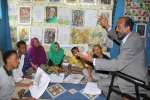Despite conflict, refugees continue to arrive by boat in Yemen
Briefing Notes, 27 October 2015
This is a summary of what was said by UNHCR spokesperson Adrian Edwards – to whom quoted text may be attributed – at the press briefing, on 27 October 2015, at the Palais des Nations in Geneva.
Despite on-going conflict and a deepening humanitarian crisis, almost 70,000 refugees, asylum-seekers, and migrants – primarily from Ethiopia and Somalia – have arrived by boat in Yemen so far this year. More than half of these arrivals have been since the conflict erupted in March.
UNHCR and its partners provide shelter, food and medical care in the Mayfa'a reception centre for those arriving on the Arabian Sea coast.
For those arriving along the Red Sea coast, reception facilities have been suspended after an attack destroyed a village hosting new arrivals in Bab el Mandab (last week, the remaining reception installations were looted). As a result of the attack, two partner staff who were working in the transit centre were killed: a Yemen Red Crescent medical assistant and a Somali refugee who was working as an interpreter.
Travel to Yemen is particularly perilous – three weeks earlier a boat with migrants and refugees capsized in the Arabian Sea en route to Yemen. Of the 68 passengers, only 33 survived: 32 were rescued by a passing boat and one managed to swim to shore. UNHCR's partner, Nansen award winner Society for Humanitarian Solidarity (SHS) arrived to take the survivors to their clinic in Mayfa'a for treatment. Since the beginning of the year there have been 88 recorded deaths at sea between the Horn of Africa and Yemen.
Most of the movements to Yemen have shifted to the Arabian Sea coast where people believe the situation is calmer – over 10,000 new arrivals in September, a 50 per cent increase on August, and over 10,000 so far in October. UNHCR and its partners have been able to provide reception and medical services. While some are Somali refugees who had previously fled Yemen, the majority are Ethiopian migrants for whom Yemen is a transit stop on a journey in search of better opportunities.
Yemen itself is meanwhile seeing a continue rise in the number of people who are displaced internally. On 15 October an IOM-UNHCR displacement-tracking mechanism published new data showing that the IDP population has reached a record-high of 2,305,048 people.
This figure is up from 545,719 individuals in mid-May. Today close to one out of ten Yemenis has had to seek refuge elsewhere in the country as a result of on-going conflict or lack of basic services and a minimum of livelihood opportunities. UNHCR along with other humanitarian actors continue to support the Yemeni people in addressing their needs despite the tremendous challenges.
UNHCR has provided emergency relief items to 22,883 IDP families (147,386 individuals) since the end of March. Access to the affected populations, however, remains a key concern as many of those in dire need remain in areas cut-off due to conflict. UNHCR is monitoring the conditions of displaced people with specific needs such as women, children, older persons and those with medical conditions. Through regular assessments it is able to target the delivery of its protection services to those with critical needs. Community centres also provide legal and social services.
Regrettably, the conflict rages in the country and the Yemeni population are bearing the brunt. UNHCR calls on all parties to the conflict to protect the lives and rights of civilians, including refugees and the internally displaced. Refugees have lost their livelihoods and many are again uprooted as they move to other parts of the country. UNHCR has increased its social assistance and protection services to the ever-increasing number of vulnerable refugees.
Today Yemen hosts 264,615 refugees, of which 250,260 are Somali. Over 121,000 people have fled Yemen to neighbouring countries since March.
For more information on this topic, please contact:
- Teddy Leposky on mobile, +967 71 2222 5121 (Yemen); +962798660268 (Jordan)
- Adrian Edward in Geneva, on mobile +41 79 557 9120
- Andreas Needham in Geneva, on mobile +41 79 217 3140












































